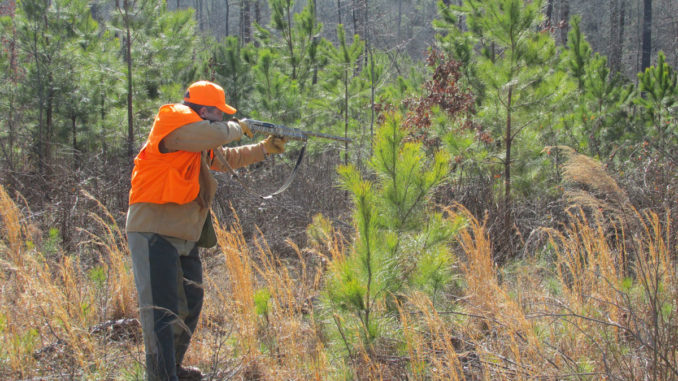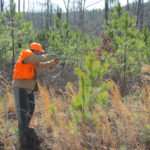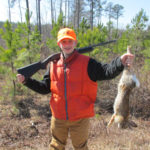
Look for young cutovers and you’ll find rabbits throughout South Carolina’s Upstate
Our truck followed a long, gravel road through the Sumter National Forest near the border of Laurens and Newberry counties. Cutover land lined both sides of the road for more than a mile — prime habitat for cottontail rabbits — and after another half-mile, we found a safe place to park.
Unsheathing my 20-gauge shotgun as the 10 beagles began to stir in the dog box, it seemed the day was going to be full of excitement.
Rabbit hunting in South Carolina has a long tradition, and although it can be done without dogs, using beagles to run bunnies is the norm. The music of beagles chasing through coverts, thickets and pine plantations is as sweet as it comes.
Eric Braselton of Greenville has embraced running his 13-inch beagles after Upstate cottontails.
“Running my dogs is about as fun as it gets in the outdoors” Braselton said. “I love everything about this sport, from breeding the dogs, to training them as puppies to, of course, hunting the rabbits.
“Sure, we want to kill the rabbit; it’s a reward to the dogs, and to us. But the race is really what it’s all about.”
Braselton is a young hunter who embraces tradition, choosing to use a side-by-side, 12-gauge as his shotgun of choice and carrying a family heirloom bullhorn to call his dogs. But don’t be fooled by his age; his knowledge of beagles and how they interact with rabbits translates into a lot of success for those who have the opportunity to tag along.
South Carolina is blessed with a lot of good rabbit hunting ground. Public land is abundant throughout the piedmont and Upstate. Key habitat for rabbits includes planted pine plantations, recent cutovers and those that are between two and 10 years old. As the pines grow taller, they shade out the undercover and the rabbits — needing plenty of cover to hide from everything that’s trying to eat them — leave.
Cottontails have a hard life. They have been referred to as “the shrimp of the land.” From four-legged predators to avian predators, rabbits are on everyone’s menu. To handle this, they are prolific breeders and are able under most circumstances able to handle a lot of predation.
Braselton prefers areas featuring young pine plantations.
“Rabbits need a lot of ground cover to survive, and these plantations provide a lot of cover.”
The Sumter National Forest’s Enoree District encompasses more than 170,000 acres in Newberry, Union, Chester, Laurens, and Fairfield counties, and much of the land has excellent rabbit habitat. The forest’s Long Cane District, headquartered in Edgefield, covers more than 120,000 acres in Abbeville, Edgefield, McCormick, Greenwood and Saluda counties.
A phone call to the district ranger offices will help hunters who want to find good rabbit cover. Contact Beth LeMaster of the Enoree District (803-276-4810), J.R. Kirkaldie of the Long Cane District (803-637-5396) and Mike Crane of the Andrew Pickens District (864-638-9568).
Areas near the town of Jalapa have a lot of good cover, as do areas near Whitmire in Newberry County; they offer 3-year-old pine plantations with and a lot of briars and brambles that rabbits prefer.
Good beagles will plunge right into the thickets when the scent is strong, and the chase through cover is slow, allowing hunters to get into position for a good shot.
“Often in this thick cover, the rabbit is a couple hundred yards ahead of the dogs, just loping along,” said Braselton. “One reason I prefer the 13-inch beagle is because they can get in and through the thick cover easier.”
Hunters pay close attention to the chase, listening and looking to see the rabbit coming far ahead of the dog, often getting relatively easy shots because the bunnies are not moving at full speed. Stealth on the part of hunters can lead to a lot of one-shot kills.
A beagle pack will usually evolve into a well-oiled machine. The dogs will establish an order in their pack. One will be what is known as a “jump dog” — the dog that has the best nose and will silently find the rabbit and jump it from its hiding place. The rest of the pack will fall in line and begin the chase. In many cases, the rabbit will run a big circle and return to the spot where he was first jumped. Good hunters will position themselves near the place the rabbit jumped and wait for the dogs to run the rabbit back to them.
“I personally like to follow the dogs, but having a shooter standing near where the rabbit jumped is a good strategy.” Braselton said. “The funny thing about rabbits is, you can hunt this cutover today and not jump a rabbit, come back tomorrow and have four or five great races.”
Braselton typically hunts at least twice a week during the Nov. 26-March 1 season, and he tries to hunt more often, when possible.
“A lot of the land I hunt is in deer clubs, and they won’t let me hunt during the deer season, but once January comes, I have a lot more land to chase rabbits,” he said.
Charles Ruth, deer and turkey coordinator for the S.C. Department of Natural Resources said rabbit hunting doesn’t have any apparent effect on deer hunting.
“While we have not done specific research on rabbit hunting, studies do show that when hunting with dogs on a particular property, the deer just move out of the way and come right back once the hunters leave,” he said, referencing a study that showed raccoon hunting does not adversely affect deer hunting. “Beagles typically do not range nearly as far, so it would be safe to say, their impact could be less than that of the larger hounds.”
Rabbit hunting in the piedmont and Upstate may not be as popular as it was a generation ago, but thanks to hunters like Eric Braselton, the sport is alive and well. It is definitely one that all hunters can enjoy. Few things can brighten a cold January morning like the music of a pack of beagles hot on the trail of a Carolina Cottontail.




Be the first to comment